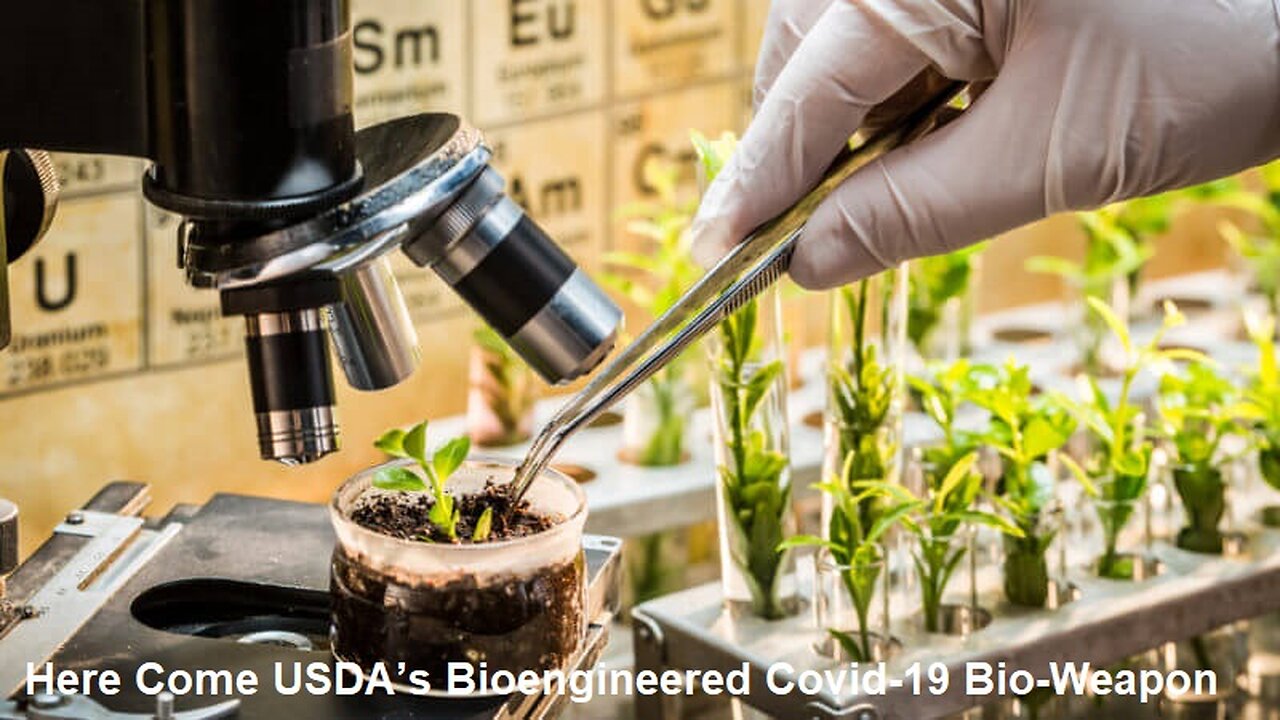Premium Only Content

In-Depth Plant-Based Covid-19 Vaccine People Testing's Now-You Will Eat Your Shot
Anti-GMO forces target New Breeding Techniques (NBTs) despite similarities to conventional crops For years, critics of GMOs have focused on the idea that modern technologies have allowed plant breeders to take genetic material from one species and add it to another—adding ‘foreign genes’, they call it.
These transgenic crosses are responsible for most of the GMO crops that dominate US farmland. But they’ve also offered a rallying point for critics, who’ve built a deceptive narrative around the idea that these “Frankenfoods” should be feared and shunned by consumers.
Among the best-known example is the infamous “fish tomato”—a tomato that was given an antifreeze gene from a flounder to make it less vulnerable to frost. The tomato was never commercialized. There is no approved fish tomato. Yet the dominant visual meme on the web when you search for GMOs involves a tomato with a syringe injecting ‘dangerous GMOs) into it, a pure fabrication.
From a science perspective, however, this has never really been an issue. Certainly, there can be reasons for caution—for example, moving genes from a peanut into another food item could create issues for people with peanut allergies.
The "body" is your "temple," a sacred place, where you and only you can go within to heal, without any outside influences. This is a clear violation not only of your sacred space, but you rights Humanity. You are being forced to "conform" to the ways of "The Giants" throughout Humanity, those in power; beware! How about the animal parts like fluids taken from the hearts of calf’s ripped from their mother’s wombs which they add to a specimen being isolated doesn’t this count it’s all part and parcel of the development of those cells being grown in the plant.
But genes are genes. We share about 97.5 percent of our working DNA with mice, which is why they make such good lab subjects. With chimpanzees, the number rises to 98.5 percent. And from the land of the weird, we share roughly half of our DNA with banana plants.
The reality is that life shares genes because all living things share a common ancestry. Genes are expressed differently in each living being, but also are in no way “foreign.” That may be a popular word for anti-GMO activists, but it’s not a term that scientists use.
Yet this kind of visual and written demonization continues. But with the advent of gene editing, and the CRISPR revolution, this talking point may largely end. Scientists are finding ways to bypass the objections to the transference of genes by using new breeding methods developed from a growing gene-editing toolbox.
Among the most important of these is CRISPR, which allows scientists to make precision edits to plant and animal DNA, adding useful traits, usually without inserting genetic material from another species.
There are also a number of other innovations, loosely grouped together under the umbrella of New Breeding Techniques (NBTs). Among them are, zinc finger nuclease, TALENs and meganucleases. CRISPR has attracted the most attention because it is more efficient at editing DNA.
NBTs are just a natural progression in the application of science to agriculture. This, after all, is what humankind has been doing for thousands of years through the processes of selecting for traits. Traditional methods include cross-breeding, hybridization, grafting, mutagenesis, protoplast fusion, marker-assisted breeding and genetic modification. The new breeding techniques that are being developed are needed to boost food production for a growing world population that is expected to reach 10 billion by 2060.
NBT products on sale and in the pipeline
Several companies and organizations are developing gene-edited food crops and medicines, which they hope to bring to the market over the next few years:
DuPont plans to sell within four years a gene-edited variety of waxy corn that will be used to thicken food products and make adhesives.
Calyxt is developing a strain of wheat that has been gene-edited to reduce its gluten content, a species of millet with a delayed flowering time and is working on a soybean variety that produces healthier vegetable oil, which it hopes to have on the market by the end of 2018. Calyxt has received confirmation that six of its gene-edited plants will not be regulated as GMOs, including an alfalfa plant that has less lignin, making it easier for cows and horses to digest.
Another company, Cibus, has developed a variety of canola that is resistant to certain herbicides.
Yield 10 has developed a gene-edited Camelina sativa or false flax, with enhanced omega 3 oil. It is used as a biofuel and as a substitute for fish oil in aquaculture.
Sophien Kamoun, who leads a research group at the Sainsbury Lab in Norwich, UK, is applying CRISPR technology to fight fungal diseases in potatoes and tomatoes.
Scientists at the John Innes Center in the UK have developed a beetroot that can produce L-Dopa, a drug that is used to treat Parkinson’s disease.
A recent study led by Noel Sauer of Harvard, which was published in the journal Plant Physiology, noted that non-GMO precision genome editing is “a highly effective method of introducing herbicide tolerance, specifically in flax.”
Another new process involves silencing, or turning off, specific genes in plants and animals. Scientists in Australia used this technique to protect tobacco plants from a virus for 20 days using a single application of a gene-silencing spray. Okanagan Specialty Fruits has used gene silencing to develop non-bruising apples and Simplot has utilized the technology to create bruise free potatoes.
Anti-GMO backlash
Having failed in their efforts to stop GMOs by raising unsubstantiated ‘Frankenfood’ safety concerns, opponents are now targeting these new technologies. Among other things, they argue that NBTs are inherently risky because of unknown consequences for human and animal health and the environment.
“[It] entails numerous risks and uncertainties,” says Franziska Achterberfer, Greenpeace’s EU Food Policy Director. The engineering process is not well-understood and can result in unexpected and unpredictable effects on the environment and human and animal health.”
Christoph Then, head of Testbiotech, an anti-GMO NGO, argues that editing could create radical changes to the genome:
We do not have the experience to declare these products safe. If these new techniques are not regulated, there will be no transparency, no choice for farmers and consumers as well as no possibility of safeguarding human health or protecting the environment.
They also complain about the lack of long-term studies demonstrating the safety of foods created using these techniques. “It is widely accepted in the scientific community that there can be off target effects to the genome when the technologies are utilized. GMOs, including the products of these new technologies, have not been adequately tested—no long-term feeding studies have been conducted—and people are starting to connect these experimental technologies to health concerns,” argues Megan Westgate, executive director of the Non-GMO Project.
This echoes a similar argument made for years over traditional GMO foods, despite the fact that these foods enjoy overwhelming support in the scientific community and US government regulators. In fact there have been dozens of long terms studies showing no effects, and no health problems have been found in humans or animals after 21 years of use and trillions of meals.
Could NBTs be accepted as organic?
Genetic modification is a breeding technique. There is no theoretical reason that a gene-edited crop (or a GMO for that matter) could not be grown using organic practices. The opposition is ideological, rooted in the politics of the anti-GMO movement.
There are some organic farmers that would like to explore the possibility of using seeds developed using NBTs. They note that new breeding techniques could be useful in producing crops that are disease-, drought- and stress-resistant and nutritionally enhanced. They say that organic farming already utilizes mutagenesis and therefore new NBTs similar to mutagenesis may be acceptable.
Raoul Adamchak, an organic farmer who is married to the noted plant geneticist Pamela Ronald, has maintained an open-minded view of the new technologies:
To be accepted by the organic community, using CRISPR would have to be seen as being a better method of crop improvement than mutational breeding, and of course it is. It is more precise than mutagenesis and avoids unwanted mutations, opening up possibilities for crops which couldn’t be developed using older techniques. As long as mutational breeding is accepted by the National Organic Program, then this type of CRISPR function should be accepted as well.
But the national organic organizations and indeed organic organizations in almost every country have issued statements opposing the embrace of gene editing and NBTs. This opposition was highlighted in November of 2016 when the National Organic Standards Board (NOSB) voted unanimously to recommend to the USDA to prohibit all forms of GMO 2.0 technology, including gene-editing, gene silencing and synthetic biology, from use in organic farming.
The Board’s hard fought proactive stance…will both help to preserve the integrity of organic standards and raise awareness about this virtually unregulated and unlabeled form of genetic engineering. It’s critical that organic standards treat new types of genetic engineering that are rapidly entering our food and consumer products as rigorously as the first generation of GMOs.
How much of this criticism and caution is valid?
As was the case of GMOs, these negative campaign tactics against NBTs could ignite a public backlash against them, leading to demands for stifling regulations that could slow innovation and add to the cost of funding new food science projects.
The scientific community and companies involved in new breeding technologies are trying to answer these claims, and refute the ones that are wrong or misleading.
“Basic gene-editing makes mutations that are indistinguishable from those found in conventional breeding so it makes no sense to call these GMOs,” says Huw Jones, a professor of translational genomic at Aberystwyth University:
Better to regulate them simply as novel foods … reducing overly burdensome costs and streamlining regulation for gene-editing plants with no foreign DNA would not only be logical but allow smaller plant breeders and research organizations to see these benign methods for public good breeding projects in locally important crops and focus on less-profitable traits for sustainable agriculture and nutritional quality.
Opponents of NBTs continue to insist that NBTs present such serious risks that we should forgo using them because of the potential damaging consequences to our health and the environment. These were the same arguments leveled against GMOs and they proved to be without merit.
In reality, the greater danger is to reject them. Without them we may not be able to protect our food resources from the effects of climate change and the ravages of crop and animals diseases and pests. They could also prevent us from developing nutritionally-enhanced foods to help those around the world struggling with malnourishment. Shutting the door or stifling New Breeding Techniques will mean we would be utilizing less productive and more expensive means of growing the food we need to consume. A version of this article first appeared on the GLP on February 26, 2018.
Confused about the USDA’s bioengineered food labels? Here’s everything you need to know Here's everything you need to know about USDA’s National Bioengineered Food Disclosure Standard
In December 2018, United States Department of Agriculture (USDA) finalized the standards for mandatory “GMO” labeling by releasing the “National Bioengineered Food Disclosure Standard” (or NBFDS). The NBFDS establishes the rules of the road for disclosing which foods in the U.S. have been or may have been bioengineered (BE) and is enforced by the Agricultural Marketing Service (AMS), a sub-agency of the USDA.
GMO labeling has been a contentious topic for many years. Anti-GMO activist groups have traditionally pushed for a “warning” on foods that could be “contaminated” with GMOs. On the other hand, scientists, food companies, and farmers who create and grow GMOs generally pushed back on mandatory labeling of a food produced with biotechnology, because mandatory labels in the U.S. have historically been used to identify health or nutritional information. GMO foods, however, have been proven to be just as safe and nutritious as their non-GMO counterparts, therefore needing no “warning” labels. Between these two poles, consumers have grown increasingly interested in learning more about the food they eat, including information about foods produced with biotechnology. In fact, data shows that 3 in 5 consumers want to know more about GMOs.
USDA’s final labeling standard for bioengineered food is an important solution for consumers. First, the labeling standard acknowledges that many people want to know if the foods they are consuming were derived from “GMO” (bioengineered) crops. Just as importantly, the standard provides this information without frightening imagery that could lead consumers to believe GMO/BE food is labeled because it is something to be concerned about or avoided entirely. About GMO/BE labels, USDA explicitly states:
“Nothing in the disclosure requirements set out in this final rule conveys information about the health, safety, or environmental attributes of BE food as compared to non-BE counterparts. In fact, the regulatory oversight by USDA and other Federal Government agencies ensures that food produced through bioengineering meets all relevant Federal health, safety, and environmental standards.”
GMO labeling may take effect as early as February 2019, but is mandatory for all retail food products that are bioengineered or contain bioengineered ingredients by January 1, 2022.
Why ‘bioengineered’ and not ‘GMO’?
Bioengineered may be a new term for many consumers, but it is honestly a much better term for the 10 “GMO” crops commercially available today in the U.S., as well as the few other crops currently in production, though not yet available for purchase, or already commercially available in other countries. (Read the full list of bioengineered foods at AMS.USDA.gov)
The acronym GMO literally stands for “genetically modified organism.” While “GMO” is the most commonly used term for crops bred through transgenesis, the breadth of this term has been creating a good deal of confusion for the average consumer who may not have a deep understanding of farming or food production. After all, in the 1900’s roughly 40% of the U.S. workforce was involved directly in agricultural production. Today that number is just 2%.
The term “GMO” creates confusion because virtually everything we eat has had its genes modified in some way, whether through very traditional plant breeding processes or through more modern means of seed breeding. The four main methods of seed improvement used to create the foods we eat today include:
Selective breeding, which humans have been doing for thousands of years. Bananas, broccoli, and citrus all come from selective breeding.
Hybridization/cross-breeding, which humans have been doing for over 200 years. Seedless grapes and watermelons are created this way, as are most apples and all that produce that sounds like hybrids – pluots, tangelos, etc.
Mutagenesis for seed improvement started in the 1920’s. Mutagenesis uses radiation and other mutagens (physical or chemical) to induce random mutation in plants, activating new, desirable varieties, like the deep color and signature flavor of Ruby Red grapefruits.
Transgenesis, which is what people typically mean when they talk about GMOs. Transgenic crops have precise, limited genes added or silenced through bioengineering to achieve a beneficial outcome, like reduced food waste through non-browning or significant, positive environmental impacts through herbicide tolerance or pest resistance.
What these four seed improvement techniques all have in common is that genes in the food change—they all have been genetically modified at some level. Some modifications happen in the thousands (mutagenesis) and some are limited to 1 or 2 genes (transgenics).
This means that “GMO” or “genetically modified” is simply too vague of a phrase to talk about one type of breeding technique, potentially referring to any or all of them. “Bioengineered” or “BE” gets much closer to the foods consumers are actually trying to learn about – transgenic crops or the foods, fuels, and fibers derived from them.
Who and what needs to disclose bioengineered food ingredients?
A bioengineered food is defined by USDA as “a food that contains genetic material that has been modified through in vitro rDNA techniques and for which the modification could not otherwise be obtained through conventional breeding or found in nature.” Labels for these foods are now mandatory under the National Bioengineered Food Disclosure Standard.
In the simplest terms, any food intentionally containing genetic material derived from GMO alfalfa, canola, corn, cotton, papayas, potatoes, soybeans, squash, sugarbeets, or Arctic™️ Apples must bear a BE label.
A few other foods need to or will need to be labeled as well. Bt eggplant from Bangladesh is required to bear the label, but since the U.S. prohibits imports of eggplants from Bangladesh at this time, it is unlikely the label will be seen on this food. Future foods that contain genetic material derived from pink-fleshed pineapples or AquAdvantage® salmon – neither of which are commercially available yet, but are currently in legal production – will also require labeling. The USDA will review the list of bioengineered foods annually and make any needed updates based on new crop approvals in the U.S. and around the world.
While that is the general rule, there are a few nuances and exceptions that are critical to know:
This labeling law applies to foods that are subject to the labeling requirements under the Federal Food, Drug, and Cosmetic Act (FDCA). GMO crops are used to make a ton of non-food products, spanning from gasoline to blue jeans. These are not under the jurisdiction of the USDA’s Agriculture Marketing Service (AMS), and as such are not mandated to be labeled.
BE-labeled food must include genetic material. Whole food products like corn or edamame contain DNA, but highly refined foods like corn syrup or soy sauce do not. Because there is no genetic material present in highly refined foods – GMO or not — they are not required to bear a BE label.
Some things we consume – like vodka – are regulated by different government agencies. Alcohol is regulated by the Federal Alcohol Administration Act (and for the most part does not contain genetic material), and is likely not subject to this labeling regulation—with the exception of wines with less than 7% alcohol by volume and beers brewed without malted barley and hops.
The genetic modification of bioengineered food products could not have been obtained through other breeding techniques. This means hybrid crops or crops made by mutagenesis or through selective breeding, such as pluots—even though their genes have certainly been modified—are not required to bear a BE label.
Here’s the one big caveat:
There are a bunch of other food labeling regulations and standards already in place in the U.S. for meat, poultry and eggs through the Federal Meat Inspection Act (FMIA). The primary ingredient of any food determines which agency’s labeling regulations must be followed. If the primary ingredient (or second, if the first is water or broth) would independently be subject to labeling under the FDCA, the product must follow AMS' labeling standard. If a product is made with meat as the primary ingredient, it is subject to FMIA’s labeling standards and regulations, and will not be required to use the AMS BE label. However, that product could be voluntarily labeled; many producers have been voluntary disclosing for years.
There are a few exemptions to the National Bioengineered Food Labeling Standard.
In addition to the cases above where AMS’ GMO disclosure is not applicable, there are a few cases in which BE labeling is exempted. Those exemptions are as follows:
Incidental additives do not need to be disclosed. This could include enzymes, yeast, and rennet, among others. Incidental additives are already excluded from inclusion on ingredient lists (as outlined by the FDA), as they have no functional or technical effect, are processing aids, or are migrated from equipment or packaging. However, if a bioengineered yeast, enzyme or other organism doesn’t qualify as an incidental additive it would most likely require disclosure.
Food served in a restaurant or similar retail food establishment (e.g., a food truck, bar or cafeteria) and very small food manufacturers (<$2,500,000 annual receipts, which is the same exemption for other USDA and FDA regulations) are exempt.
Food certified under the National Organic Program. Organic certification and the bioengineered labeling standard are regulated by the same agency within USDA, the Agricultural Marketing Service (AMS). To meet the USDA Organic regulations and receive certification, farmers and processors must show – among other things – that they aren’t using GMOs. Therefore, Certified Organic label is enough to tell consumers what they want to know about GMO content in these foods.
Animals fed bioengineered (GMO) feed, and their products. This exemption directly addresses questions and claims about the impact of GMO feed on meat, milk, eggs, and other animal products. Not only has “GMO” DNA never been detected in any meat, eggs or milk from livestock, there is no reason to believe it would, because that’s not how digestion works. When humans or animals eat food that contains DNA or proteins, they are “released” from the food and processed by the digestive system in the gastrointestinal tract. The same way eating chicken doesn’t make you cluck or grow feathers and eating spinach doesn’t make you green, animals (human, livestock, or otherwise) that eat GMO crops don’t absorb that DNA into their bodies.
As with all food in the U.S., there are thresholds set for inadvertent or technically unavoidable presence of bioengineered substances. Any intentional presence of BE substances must be disclosed no matter how much is present, but the threshold for inadvertent or technically unavoidable bioengineered substances is 5% which “…appropriately balances providing disclosure to consumers with the realities of the food supply chain.”
Voluntary labeling is allowed.
Foods that are not subject to the national labeling standards but whose manufacturers, importers, or retailers want to disclose these ingredients anyway have the ability to do so voluntarily, provided they adhere to guidelines established under the NBFLS.
The same labeling standards and disclosure guidelines for foods that are required to disclose must be used – where they go, what they say, what information is provided. This ensures consistency for consumers.
Where to look for bioengineered disclosures
There are specific presentation guidelines for disclosing bioengineered ingredients that must be followed to ensure standardized information about foods that contain GMOs is accessible to anyone at any time. BE food disclosure must be “conspicuous” – big enough and placed where anyone could reasonably see it on the packaging – and can take the form of on-package text, an electronic or digital link, SMS/text messaging, or through the use of one of the four below symbols.
Symbols These symbols are meant to be placed on the information panel (near where you find nutritional information), on the front of the package, or in the most conspicuous location possible.
Text
A package can have text printed that displays clear disclosure statements like “Bioengineered Food” or “Contains a BE Food Ingredient.” The limitation to text is that it cannot say “may” – “may” include, “may” contain, etc. It is all or nothing – something either contains genetic material that has been bioengineered, or it doesn’t.
Electronic
A QR code may be used to direct consumers to a website that contains information about BE ingredients. If a QR code is used, it must include clear language, like “scan here for more food information,” and must also provide consumers with a phone number they can call. Any website or phone number connected to labeling disclosure cannot collect personal information or provide consumers with any marketing material. This website and phone number must be active 24/7, 365 days a year.
SMS/text message
Food manufacturers, importers, and retailers can provide a number that consumers can text message for information. Again, this number cannot collect any personal information or be used in any way for marketing. This number must be active 24/7, 365 days a year.
For very small packages
If a package is simply not large enough to house any of the above material, a shortened version of the required disclosure statement can be used, or a URL can be provided.
Deciphering common food labels
Label overload is a real thing; we encounter an overwhelming amount of often confusing and conflicting information on or about the foods we shop for, but not everything on or about the food you eat is about health, safety or nutrition. There’s a big difference between nutritional information and marketing lingo, and sometimes it’s hard to know the difference.
Some labels—like “Certified Organic”—*feel* better for consumers, but an Organic label has nothing to do with safety, health or nutrition. Organic agriculture is defined as “...the application of a set of cultural, biological, and mechanical practices that support the cycling of on-farm resources, promote ecological balance, and conserve biodiversity.” It is one of several farming practices; Organic isn’t about growing healthier or safer crops, it’s just a different way of growing them.
Other labels—like “bioengineered”—may *feel* less good, as if the label exists so you can avoid something that could be harmful. This couldn’t be further from the truth. A bioengineered label also has nothing to do with safety, health or nutrition, it is simply a way to give consumers the information they have asked for.
“Nothing in the disclosure requirements set out in this final rule conveys information about the health, safety, or environmental attributes of BE food as compared to non-BE counterparts. In fact, the regulatory oversight by USDA and other Federal Government agencies ensures that food produced through bioengineering meets all relevant Federal health, safety, and environmental standards.”
There are also a whole host of labels created by private companies and manufacturers that are not government regulated. While the FDA prohibits labels that mislead consumers, explicitly prohibiting labeling that implies any food is “safer, more nutritious, or otherwise has different attributes than other comparable foods because the food was not genetically engineered,” the popular (and problematic) Non-GMO Project has made an industry out of exploiting consumer fear by convincing the public that GMOs are contaminants to be avoided and advocating that consumers should choose foods with their labels to avoid them — all while charging producers and consumers a premium for those labels. These “butterfly” labels, and the message that GMOs are less than other foods, are extremely problematic, as they willfully defy established government labeling standards and ignore the overwhelming scientific consensus that GMOs are as (or more) safe and nutritious as their non-GMO counterparts.
So how is the average consumer supposed to decipher all of these different messages on and about food, and know what is about health and safety and what is just marketing or informed choice? Nutritional information is always displayed on the information panel. By federal law, it must include anything you need to know about the health implications of what you are eating, including nutritional content, ingredients and known allergens. Other nutrition content claims (e.g., low fat) are also dictated in detail by the FDA. If you want to know if the food you are eating is healthy for you, look here. If you want to know how it was bred or grown, look for the Organic or Bioengineered label, found adjacent to the information panel or on the front of the package.
It’s a messy story. The new USDA rules for labeling foods with “bioengineered” ingredients, which became fully effective January 1, 2022, are being challenged in court. Opponents, including the Center for Food Safety, an advocacy group, are plaintiffs in federal court in San Francisco, suing USDA to stop the effectiveness of the new rules.
If the court agrees that any of the plaintiffs’ objections are valid, the court will temporarily, or permanently, prohibit the rules from going into effect or being enforced.
Let’s take a close look at some of the issues raised in the lawsuit, some of which are commonly raised in administrative cases. For background, you can see my July 2018 column in PW for a summary of the rules and even some of the controversy.
The USDA itself refers to its rules, which it calls the National Bioengineered Food Disclosure Standard, as intended to require disclosure of information about bioengineered foods and ingredients. (Separately, USDA offers guidance for those who want to claim their foods contain no bioengineered ingredients.)
The new requirements apply to foods that are required to be labeled under FDA’s requirements and to meat and poultry products required to be labeled under USDA’s. Yo, packaging makers and users: packaging components that migrate into food are not “food” for purposes of these new bioengineered food disclosure requirements. And, for what it’s worth, neither are animal foods.
“The Standard defines bioengineered foods as those that contain detectable genetic material that has been modified through certain lab techniques and cannot be created through conventional breeding or found in nature,” explains a USDA document.
USDA’s Agriculture Marketing Service generated a list of bioengineered foods to help companies comply. “The List of Bioengineered Foods is alfalfa, apple (Arctic™ varieties), canola, corn, cotton, eggplant (BARI Bt Begun varieties), papaya (ringspot virus-resistant varieties), pineapple (pink flesh), potato, salmon (AquAdvantage®), soybean, squash (summer), and sugarbeet. These foods comprise most of the bioengineered crops or foods grown in the world and, therefore, most of the bioengineered food and food ingredients.” USDA will conduct annual reviews of the list.
“If a food or food ingredient is on the List of Bioengineered Foods, and the regulated entity’s records show that the food is a bioengineered food or does not indicate whether or not the food is bioengineered, the food must bear a … disclosure,” says USDA.
Perhaps the most controversial element of the program is that food makers, importers, and some retailers have their choice of means of making the disclosure. They can put text or a symbol on the food’s label, or use an electronic or digital link, or a text message. Small food makers, or small packages, can disclose via a phone number or web address.
Another controversial element of the new program is the use of the phrase “bioengineered” instead of “GMO” or genetically engineered. USDA says bioengineered is the more accurate term, but consumer advocates say it’s misleading, particularly since the public is more familiar with the other terms.
The plaintiffs say the new rules violate the law Congress passed telling USDA to make the rules, and also violates something called the Administrative Procedure Act as well as the U.S. Constitution.
That Administrative Procedure Act is extraordinarily important to our government’s operation and protection of our due process rights. It comes into play because Congress makes laws and often those laws tell administrative agencies to do one thing or another on one or another topic. For example, the law might tell an agency, “Make rules that make machinery safer for workers,” but if the agency then makes rules that are too different than the instructions Congress gave it, the rules can be invalidated.
One of its key provisions says that no agency action can be “arbitrary, capricious or … otherwise not in accordance with law,” and that’s what the plaintiffs say is true here.
They argued in a recent filing that USDA’s regulations “fall far short of fulfilling the promise of meaningful GE [genetically engineered] food labeling. Instead, … [it] excludes most GE foods from mandatory disclosure, limits the applicable labeling terminology to the obscure “bioengineered,” and allows disclosure in a form never before approved in a federal label—electronic Quick Response (QR) codes—that the Agency itself determined would conceal disclosures from many Americans. If that were not enough, … [it] forbids retailers from doing better than the feeble standard USDA set, restricting their constitutional rights to speak clearly and plainly to their own customers about GE foods using familiar means and terms.”
Are the plaintiffs right? Well, we’ll see. The plaintiffs’ motion asking for a ruling in their favor will be heard in March. Meanwhile, you can probably find some disclosure labels anyway, as some companies started already using them.
Those fed specs were inspired by a Vermont law, and though they aren’t yet final, it’s already clear that they won’t match that state’s requirements.
In May, the U.S. Department of Agriculture published its proposed regulations to implement a 2016 law to set up a standard for how foods that are, or contain, bioengineered foods would disclose that fact.
The law requires foods to “bear a disclosure indicating that the food is bioengineered or may be bioengineered.” This isn’t a safety issue, but one that some consumers are interested in nevertheless.
That 2016 law called for a National Bioengineered Food Disclosure Standard to “provide uniform information to consumers,” said USDA, and the agency says it also tried to “minimize implementation and compliance costs for the food industry.”
The public and many in industry have commonly referred to such foods as “genetically modified,” “genetically engineered,” or “GMO,” but USDA went with the term suggested by Congress, “bioengineered,” saying that it “adequately describes food products of the technology that Congress intended to be within the scope” of the law.
USDA proposes that its new disclosure requirement would apply to “food” regulated by the U.S. Food and Drug Administration as well as meat, poultry, and eggs regulated by the USDA.
Packaging companies, take note: USDA’s proposed definition of “food” that would need to be labeled as bioengineered does not include food contact materials. USDA made clear that FDA-defined “incidental additives,” which include substances migrating into food from food contact materials such as packaging (and under a longstanding regulation are not required to be listed on food labels), are not within the scope of the meaning of “food” for purposes of these new requirements.
The actual label disclosures that USDA proposes give food packagers some flexibility. There are three disclosure options for foods subject to mandatory disclosure, with even more options available for small food manufacturers, and alternative options for foods in small and very small packages.
One option is text disclosure, such as by adding “Bioengineered food” or “Contains a bioengineered food ingredient” to the label for high adoption bioengineered foods and “Bioengineered food,” “May be bioengineered food,” “Contains a bioengineered food ingredient,” or “May contain a bioengineered food ingredient” for non-high adoption bioengineered foods. Adoption refers to the extent to which the bioengineered version of the food is used in commerce.
A second option is disclosure via a symbol, and USDA has proposed and requested comments on three alternative types of symbols.
The third proposed option is electronic or digital link to a product information page, accompanied by a statement such as: “Scan anywhere on package for more food information” or “Scan icon for more food information.” This option also calls for display of a phone number with the statement “Call for more food information.”
A final proposed option is a text message where the label would bear the statement “Text [number] for more food information.”
All disclosures will have to be prominent, conspicuous, and likely to be read and understood by the consumer under ordinary shopping conditions. Proposed alternatives are offered for placement.
As for which foods will need the disclosure, the law itself defined “bioengineered” food as one ‘‘(A) that contains genetic material that has been modified through in vitro recombinant deoxyribonucleic acid (DNA) techniques; and (B) for which the modification could not otherwise be obtained through conventional breeding or found in nature.’’
At least one important aspect of the proposed program does indeed appear designed to make life easier for food companies. USDA proposes to actually list for food makers the foods for which the disclosure requirement would apply. It proposes to list foods for which commercially available bioengineering has been “highly adopted” and others for which it’s not highly adopted. The disclosure would be triggered if a food is on one or the other list or contains a listed food.
The agency’s proposed list of highly adopted commercially available bioengineered foods contains canola, field corn, cotton, soybeans, and sugar beets. The proposed list of not highly adopted commercially available bioengineered foods contains non-browning apples, sweet corn, papaya, potatoes, and summer squashes.
Surprisingly, USDA’s proposal offered alternative approaches to some issues and asked for the public to mull over the choices. It will be interesting to see how various parties react to each alternative offered. The comment period ended on July 3, 2018.
This whole public debate over whether and how to label these foods could correctly be said to have begun in Vermont. The federal law was passed in the wake of, and preempted, a Vermont law that would have called for different GMO food label disclosures.
Back when the federal law became effective, we knew the outlines of what USDA was instructed to do but had to wait for the details. Now we have the proposed details, or options for some of them, and have a better idea of what’s likely to come next. But the saga continues.
The World’s Most Dangerous Bioweapons such as Anthrax, Botulism, Covid-19/21 and Variola have been studied as weapons, engineered and in some cases even deployed to devastating affect. Army-technology lists the world’s most deadly bio-weapons.
Bacillus Anthracis (Anthrax)
Bacillus anthracis bacteria, which causes anthrax, is one of the most deadly agents to be used as a biological weapon. It is classified by the US Centres for Disease Control and Prevention (CDC) as a Category A agent, posing a significant risk to national security. The gram-positive, rod-shaped anthrax spores are found naturally in soil, can be produced in a lab, and last for a long time in the environment.
Anthrax has been used as a bio-weapon for about a century mixed with powders, sprays, food and water. The invisible, infectious, odourless and tasteless spores make Anthrax a flexible bio-weapon. Letters containing powdered anthrax spores were intentionally mailed through the US postal system in 2001 affecting 22 people of which five died.
Botulinum toxin
Botulinum is relatively easy to produce and has extreme potency and lethality. It can be distributed via aerosol or by contamination of water and food supplies. A gram of Botulinum toxin can kill more than a million people if inhaled. A Japanese biological warfare group is known to have infected war prisoners with C botulinum toxins during the occupation of Manchuria.
Botulism is a serious muscle-paralysing disease caused by a nerve toxin produced by a bacterium called Clostridium botulinum. The bacteria are found naturally in forest soils, bottom sediments of lakes and streams and the intestinal tracts of some fish and animals. All four forms of botulisms (food borne, infant, wound and animal) induce illness through a common pathway causing muscle weakness, difficulty in speaking and swallowing, and double and blurred vision.
Variola major (Smallpox)
Variola major virus causes Smallpox, a highly contagious and infectious disease that has no cure and can be only prevented by vaccination. Smallpox is believed to have been used as a biological weapon against Native Americans and again during the American Revolutionary War.
The Soviet government commenced a programme in 1980 to develop smallpox virus in large quantities stored in refrigerated tanks to use as a bio-weapon agent. The threat of smallpox being used as a biological weapon decreased when WHO launched a successful global immunisation program against Smallpox in 1967.
Francisella tularensis (Tularemia)
Extreme infectiousness, ease of dispersion, and ability to cause illness and death make Francisella tularensis bacterium a dangerous bio-weapon. People affected with Francisella tularensis experience symptoms including skin ulcer, fever, cough, vomiting and diarrhoea. Dr. Kenneth Alibek, a former scientist involved in the Soviet Union’s bio-weapons programme revealed the use of Tularensis by the Soviet Red Army against German troops in the battle of Stalingrad during World War II.
The bacterium, which is classified as Category A agent, was studied by Japanese germ warfare research units and some of the Western military powers for military purposes.
Ebola Virus
Ebola Virus Disease (EVD) is a deadly disease induced by infection with one of the Ebola virus forms. Ebola was first discovered in 1976 in the Democratic Republic of the Congo and is transmitted to humans from wild animals, causing an average case fatality rate of 50%.
Ebola as a biological weapon poses a great threat to humans because of its high case-fatality rate. It was allegedly produced as a biological weapon by the Soviet Union under a five-year plan implemented between 1986 and 1990, but evidence of it actually being used has not been found.
Yersinia pestis (plague)
Yersinia pestis bacterium, a CDC Category A organism causing pneumonic plague, can be created in a laboratory in high quantity for use as a bio-weapon. Pneumonic plague spreads from person to person and causes symptoms such as fever, weakness and pneumonia in early stage and, if not treated early, leads to respiratory failure, shock and death.
Plague has been intentionally used as a weapon since the 14th century. The Japanese Army dropped plague-infected fleas over populated areas in China and Manchuria in World War II and Soviet scientists successfully produced large quantities of antibiotic-resistant plague organisms suitable for weapons during the 1980s.
Marburg Virus
Marburg Haemorrhagic Fever (Marburg HF) is caused by Marburg virus of the filovirus family, which also includes the Ebola virus. Marburg virus is also a Category A bio-warfare agent identified by the CDC’s classification system and is hosted in African fruit bat. The virus can be isolated and produced as a biological weapon.
The Soviet Union conducted experimentations with the Marburg virus in aerosol form to transform it into a strategic-operational biological weapon. Soviet scientists were reported to have preferred Marburg to Coxiella burnetii (Q fever) as Marburg has a high case fatality rate of up to 90%.
Bunyavirus
The Bunyaviridae family of viruses includes three viruses – Nairovirus, Phlebovirus and Hantavirus. Korean haemorrhagic fever caused by Hantavirus broke out during the Korean War when an estimated 3,000 American and Korean soldiers became infected with the disease, but evidence of its direct usage as a biological weapon has not been found.
Bunyavirus causes human infections such as Hanta Pulmonary Syndrome (HPS), Rift Valley fever and Crimean-Congo haemorrhagic fever. It is transmitted by arthropods and rodents and occasionally infects humans too. The Hanta virus causing HPS causes a mortality rate of up to 50%.
Aflatoxin
Aflatoxins, a number of structurally associated harmful metabolites developed by certain strains of fungi, lead to cell or organ death, Cirrhosis liver disease resulting in liver failure and cancer.
The United Nations Special Commission (UNSCOM) in 1995 specified Iraq’s production and deployment of different munitions with Aflatoxin which were destroyed after the Gulf War. The metabolites, however, have extremely low toxicity and hence are required in large quantities to be dispersed on the battlefield for lethal impact.
A professor at the National Taiwan University claims the highly infectious virus could be ‘synthetic’ As scientists, doctors, academics and conspiracy theorists toss around ideas and speculate on where the highly infectious virus originated, a professor in etiology at the National Taiwan University has claimed that the highly infectious virus could be “synthetic” in nature – in other words, man-made.
Questions about the exact origin of the novel coronavirus have grown as it spread across China and then beyond. Hubei, the central Chinese province where it first erupted, reported 499 new cases on Tuesday, while South Korea, Japan, Singapore and Italy have become the new frontiers in the battle to contain the contagion.
Speculation has grown about how the Covid-19 virus came into being. The official conclusion by Chinese authorities is that a dingy wet market in Wuhan – Hubei’s capital – was the source of the respiratory pathogen as animal-human transmission could have occurred there.
There has been much speculation about a virology institute in the city, affiliated with the Chinese Academy of Sciences, with rumors about a leakage due to slack management triggering a public health crisis worse than the SARS incident of 2003.
Some of the more nonsensical talk includes a conspiracy theory that the United States “made” the virus to mass-infect Chinese people and stop the rise of its arch-rival.
Now a professor in etiology at the National Taiwan University has claimed the highly infectious virus could be “synthetic” in nature, or man-made.
“Researchers likely synthesized the Covid-19, although more studies are needed to be certain,” NTU professor Fang Chi-tai told a forum on disease control and prevention in Taipei held by the Taiwan Public Health Association earlier this month.
During his presentation, Fang outlined several hypotheses raised by Taiwanese and overseas researchers, including the probability that the virus was “man-made” and was leaked from the Wuhan Institute of Virology due to gross mismanagement.
Fang said the Wuhan facility’s biosafety level-4 laboratory was used to store, handle and research samples of SARS, Ebola and other deadly infectious viruses.
“Given China’s poor track record of lab safety management, including a leakage of the SARS virus at a state lab in 2004, it is possible that a virus escaped from the Wuhan facility and resulted in the epidemic,” Fang was quoted by Taiwan’s Central News Agency and the Taipei Times as saying.
He added that analyses of the Covid-19 virus have shown that it had a 96% genetic similarity with an RaTG13 bat virus also stored at the institute, and that the Covid-19 could be “manufactured” by modifying the RaTG13 virus.
Fang also revealed that French researchers had discovered four more amino acids in the gene sequence of Covid-19 than other known coronaviruses, which could be added artificially to make the viral transmission easier.
Fang’s theory is that natural mutations of viruses will only result in small, singular changes, and it is suspicious to see a naturally mutated virus suddenly take on four amino acids.
Determining the source of the virus would have important implications for epidemiology, he added, saying that if the virus was indeed synthetic, then it could be easier for it to be eradicated.
Meanwhile, Taiwan’s top research institute Academia Sinica said its researchers had already developed an antibody testing method for Covid-19 infection and made encouraging progress in synthesizing remdesivir, a medicine that many believe could cure the infection.
Taiwan’s Center for Disease Control on Tuesday sent serum samples from three people who had contact with Taiwan’s first Covid-19 fatality to the Academia Sinica, as part of a joint effort to determine the source of that infection and if the three had developed antibodies. The initial tests showed that only one sample had antibodies for Covid-19 and SARS.
The sample was obtained from a Taiwanese businessperson who was not listed as a confirmed case, as researchers believed his immune system had beaten the virus. Yet the institute said it was still a mystery whether a person who had recovered from a novel coronavirus infection could contract it again.
Another team at Taiwan’s Institute of Chemistry has also succeeded in synthesizing 100mg of remdesivir.
The synthesized drug cannot be used without the consent of a US pharmaceutical firm that manufactures remdesivir. It was reported that Taiwan was negotiating a technology transfer deal to start mass production of the antiviral drug.
Remdesivir is a novel drug developed by the California-based Gilead Sciences as a treatment for Ebola virus and Marburg virus infections, and it has subsequently been found to show antiviral activity against other viruses.
Based on its success against other coronavirus infections, Gilead provided remdesivir to physicians that treated an American patient infected with Covid-19 and was offering the compound to China for a pair of trials in infected individuals with and without severe symptoms. The mystery of how and where the virus started may take longer to discover than the cure.
-
 6:02
6:02
What If Everything You Were Taught Was A Lie?
15 days agoSo Tomorrow Is June 14 2025 Its 154 Year Old International Maritime Admiralty Law Flag Day 2025
2.39K2 -
 1:08:04
1:08:04
Jeff Ahern
2 hours ago $1.60 earnedThe Sunday Show with Jeff Ahern
18.3K6 -
 LIVE
LIVE
MissesMaam
2 hours agoParty Animals w/ Cewpins 💚✨
110 watching -
 LIVE
LIVE
ZerrickGaming
2 hours agoPlaying Siege Ranked With @Jorba4 and @JahBlessGames ! Need two more for a full Stack!
57 watching -
 LIVE
LIVE
Biscotti-B23
1 hour ago🔴 LIVE ELITE RANK PC PLAYER TRIES REMATCH ON PLAYSTATION ⚽ CUSTOMS & RANKED MATCHES
42 watching -
 10:09
10:09
Forrest Galante
9 hours agoWildlife Expert Reacts to Crazy Animal Zoo Attack TikToks
58.2K12 -
 LIVE
LIVE
Spartan
1 hour agoPro Halo Player | Grinding, Another day to try and get better
13 watching -
 4:45:59
4:45:59
Grant Cardone
7 hours agoHow to Build Wealth in 2025 - Grant Cardone LIVE!
19.8K6 -
 LIVE
LIVE
a12cat34dog
2 hours agoTHE *NEW* KRATOS IS EPIC :: God of War (2018) :: FIRST-TIME PLAYING {18+}
33 watching -
 LIVE
LIVE
Cewpins
3 hours agoBattling Rumble Gamers!🔥Gaming & Chill💨420 !mj🍃!Giveaway
112 watching